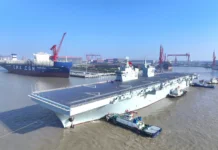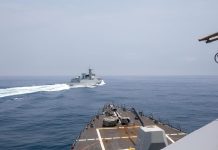
The Battlecruiser New Zealand: A Gift to Empire. By Matthew Wright, Seaforth Publishing, Barnsley, 2021. ISBN 978152678403 2 (Hardback).
Reviewed by Peter Jones
Some ships by virtue of their service deserve a book and the battle cruiser HMS New Zealand is one such ship. As a sistership to the RAN’s first flagship, HMAS Australia the book will be of particular interest to Australian readers. This book is written by the prolific and accomplished New Zealand historian Matthew Wright and handsomely published to the standard we have come to expect from Seaforth Publishing. It is also available as an e-pub and for Kindle.
The book benefits from a very nice Foreword by Nick Jellicoe whose grandfather Admiral of the Fleet Earl Jellicoe had a close personal connection to the ship and to New Zealand. Nick Jellicoe is a naval historian of note and has written a very readable history of Jutland also published by Seaforth.
I was very keen to read The Battlecruiser New Zealand as early this year I had completed the HMS New Zealand chapter for my forthcoming biography of Vice Admiral Sir Albert Poland. He had the very good fortune to serve in the battle cruiser from 1913 to 1917. From that vantage point of having trolled many of the same primary and secondary sources relating to New Zealand, I can attest that The Battlecruiser New Zealand is thoroughly researched and what is more it is very well written.
While not wanting to recap the service life of New Zealand it is important to remark on why she is so notable. She was bought by the New Zealand Government, as the title suggests, as a gift to the Royal Navy and as such she served with the Grand Fleet during World War I. Importantly, soon after her completion she conducted a circumnavigation in 1913. Her visit to numerous Kiwi ports remains the biggest maritime event in the nation’s history. An incredible 376,084 New Zealanders visited ‘their’ ship out of a national population of just over one million people. In the war New Zealand took part in the battles of Dogger Bank, Heligoland Bight and Jutland. In the latter she fired more rounds than any other British ship and unlike three other battle cruisers, she survived the battle.
New Zealand’s story is a remarkable one about a generally happy and certainly lucky ship. It is not, however, a simple story to tell. Some of the complexities are how did the idea of buying a battleship come about, why was a battle cruiser chosen instead, what was the ‘Fleet Unit’ concept, how did changing technology affect the ship’s design and performance and finally, how to graphically describe large and confusing sea battles. In all this Matthew Wright does well in a confident style. He set out to write the book for the general readership but it is devilishly hard to do. Stephen Roskill’s book on HMS Warspite probably is a shining example. I suspect, and this is no criticism of this book, that the general readers eyes will glaze over the four page discussion gunnery systems. In the same vein of the book’s 200 pages, the first 74 are devoted to her gestation. But I am reminded by a remark by a publisher who said to me “unless you include this in your book it will never be published.” I think The Battlecruiser New Zealand would have been a lesser book if it did not include these discussions.
On the other hand, I think the book would have been strengthened by two things. Firstly, some maps, particularly of the circumnavigation and of North Sea operations. The second, is as the Fleet Unit concept was earlier well explained, including as it related to Australia, it would have been useful to briefly mention that Australia vindicated that concept by deterring von Spee and, among other things, escorting the New Zealand Expeditionary Force to Samoa. Australiareappears in the book in time for her fateful collision with New Zealand and curiously, Australiais not mentioned in the Index, but neither are Queen Mary or Princess Royal. But these are minor issues.
One of the great strengths of this book is that Matthew Wright has taken onboard the scholarship of modern naval historians and in particular Jon Sumida and our former ANI President, James Goldrick, when discussing the war at sea in World War I. He often cites James Goldrick’s assessments from his acclaimed Before Jutland*. This greatly helps make sense of a complex story and explains the technical difficulties the men at sea operated under. In describing these actions Matthew Wright is both vivid in his accounts and is rigorous with the sources. As an example he has been accurate as is possible about how many hits New Zealandscored at Jutland.
Another strength of the book is Matthew Wright’s focus on people. There are an array of fascinating personalities ranging from New Zealand politicians, British admirals, the commissioning commanding officer Captain Lionel Halsey to the midshipmen and sailors who gave the ship her personality. Fortunately, Matthew Wright was able to mine the trove of surviving personal papers and accounts which give life to the ship. He deftly uses these sources to bring the New Zealand’s story alive.
The Battlecruiser New Zealand is a very fine book about a most remarkable ship.
* See the ANI Book Review on Before Jutland.
(https://navalinstitute.com.au/before-jutland-naval-war-in-northern-europe/



